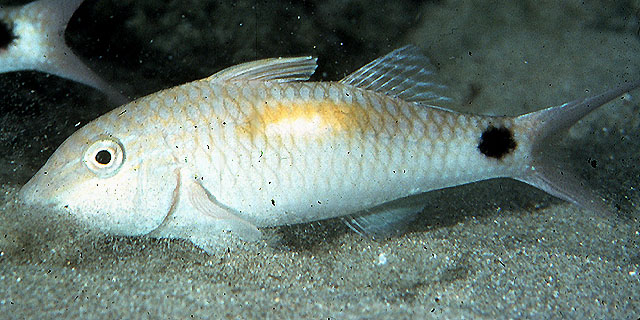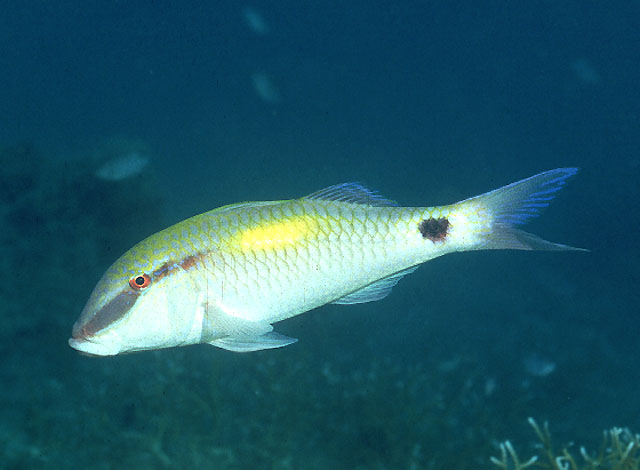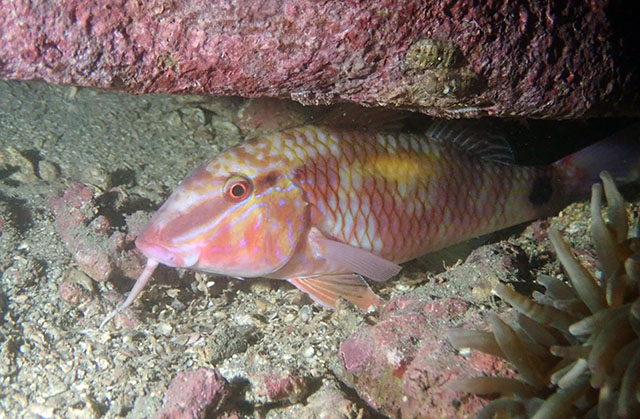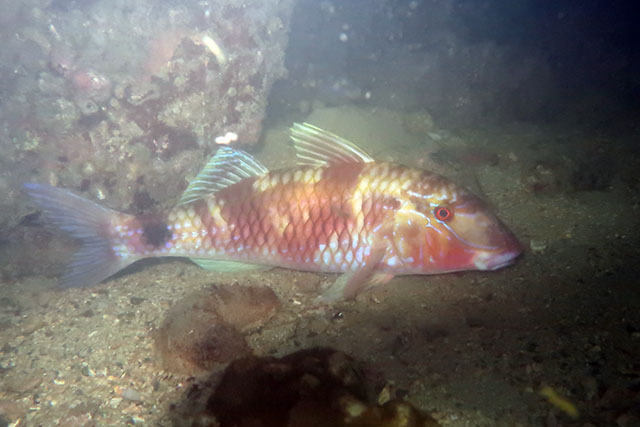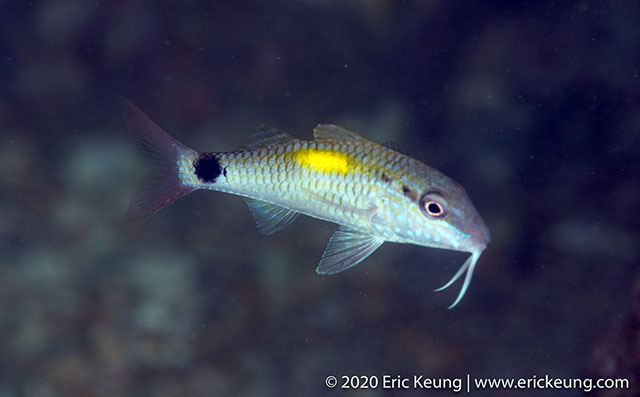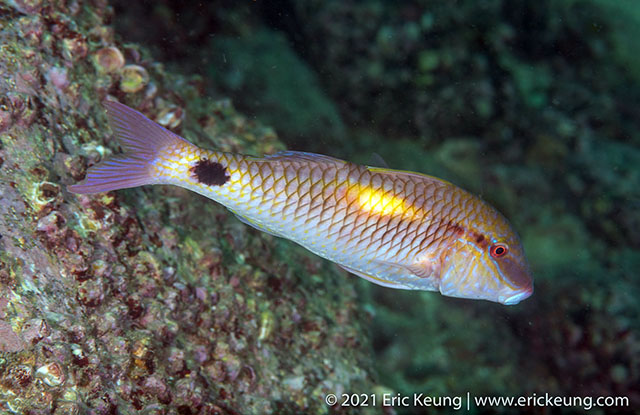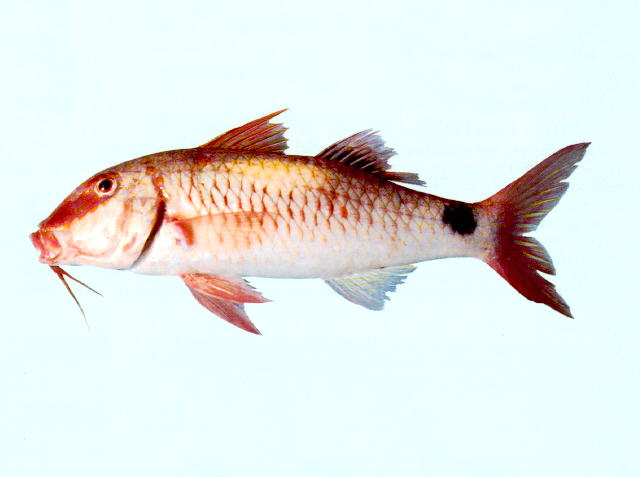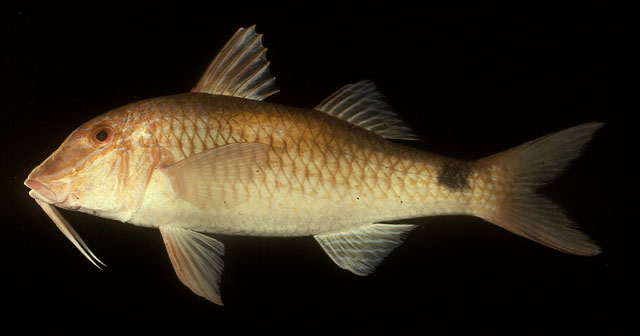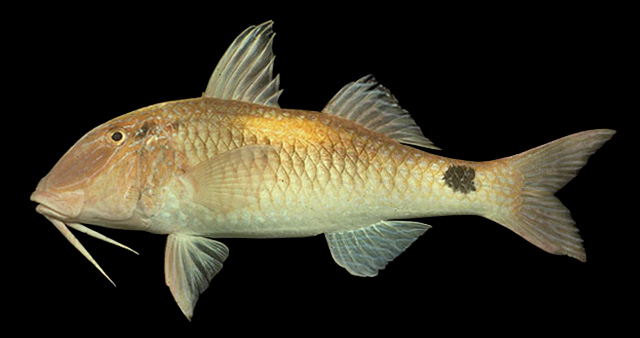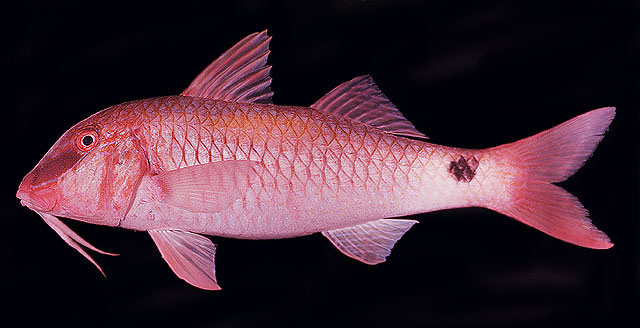Parupeneus
indicus
(Shaw,
1803)
Indian goatfish
View all media / Upload your photos and videos
Expand all
Classification / Names
Teleostei (teleosts) > Mulliformes (Goatfishes) >
Mullidae (Goatfishes)
Etymology: Parupeneus: Latin, parum, parvum = small + Peneus, the name of a river
More on author:
Shaw.
Environment / milieu / depth range / climate zone / distribution range
Marine; brackish; reef-associated; depth range 10 - 30 m (Ref. 48636); tropical; 19°N - 23°S28°E - 150°W.
Distribution
Indo-Pacific: Yemen coast of the Gulf of Aden and southern Oman, along the east coast of Africa to Port Alfred, South Africa (33°S), east to the Caroline and Somoan islands; southern Japan to southern Queensland.
Maps

Parupeneus indicus / Native range
AquaMaps Data sources:
GBIF
OBIS
This map was computer-generated and has not yet been reviewed.

Parupeneus indicus / Suitable habitat
AquaMaps Data sources:
GBIF
OBIS
This map was computer-generated and has not yet been reviewed.

Parupeneus indicus / Point map
AquaMaps Data sources:
GBIF
OBIS
This map was computer-generated and has not yet been reviewed.

Parupeneus indicus / Year 2050
AquaMaps Data sources:
GBIF
OBIS
This map was computer-generated and has not yet been reviewed.
Size / Weight / Age
Short description
Dorsal spines (total): 8; Dorsal soft rays (total): 9; Anal spines: 1; Anal soft rays: 7. Diagnosis: Pectoral rays 16 (rarely 15 or 17). Gill rakers 5-7 + 18-21 (total 24-27)> Body depth 3.25-3.75 in SL; head length (HL) 2.9-3.25 in SL; snout length 1.65-1.95 in HL; barbel length 1.3-1.5 in HL. Longest dorsal spine 1.5-1.8 in HL; penultimate dorsal ray about equal to last dorsal ray in juveniles, 1.05-1.2 in length of last dorsal ray of adults; pectoral-fin length 1.35-1.55 in HL; pelvic-fin length 1.3-1.5 in HL. Body greenish brown to reddish brown dorsally, the scale edges narrowly dark, shading to whitish or pale pink ventrally, with a nearly round black spot as large or larger than eye on side of caudal peduncle, two-thirds of which lies above the lateral line; a large, horizontally elongate yellow spot (sometimes partly white) on lateral line below interdorsal space; barbels white; irregular pale blue lines extending anteroventrally and dorsoposteriorly from eye; second dorsal and anal fins with irregular oblique pale blue lines; caudal fin yellowish gray with faint blue lines paralleling rays; peritoneum dark brown (pale brown to white in other species of the genus except Parupeneus barberinus) (Ref. 54393).
Biology
Inhabit shallow sandy or silty areas (seagrass substrata) of coastal and inner lagoon reefs (Ref. 9710, 54393). Occur singly or in schools (Ref. 5213). Large adults usually at moderate depths to about 30 m (Ref. 48636). Feed on benthic invertebrates; the diet including small crabs, amphipods, shrimps, small octopuses, polychaete worms, and small fishes (Ref. 54393). Marketed fresh (Ref. 5284).
Main reference
Randall, J.E. 2004 Revision of the goatfish genus Parupeneus (Perciformes: Mullidae), with descriptions of two new species. Indo-Pac. Fish. (36):64 p. (Ref. 54393)
IUCN Red List Status (Ref. 125652)
Least Concern (LC); date assessed: March 11 2015
CITES (Ref. 131153)
Not Evaluated
CMS (Ref. 116361)
Not Evaluated
Threat to humans
Harmless
More information
- Countries
- FAO areas
- Ecosystems
- Occurrences
- Introductions
- Stocks
- Ecology
- Diet
- Food items
- Food consumption
- Ration
- Common names
- Synonyms
- Metabolism
- Predators
- Ecotoxicology
- Reproduction
- Maturity
- Spawning
- Spawning aggregation
- Fecundity
- Eggs
- Egg development
- Age/Size
- Growth
- Length-weight
- Length-length
- Length-frequencies
- Morphometrics
- Morphology
- Larvae
- Larval dynamics
- Recruitment
- Abundance
- References
- Aquaculture
- Aquaculture profile
- Strains
- Genetics
- Allele frequencies
- Heritability
- Diseases
- Processing
- Mass conversion
- Vision
- Pictures
- Stamps, Coins Misc.
- Sounds
- Ciguatera
- Speed
- Swim. type
- Gill area
- Otoliths
- Brains
Estimates based on models
Preferred temperature (Ref. 123201): 26.2 - 29, mean 28.2 °C (based on 442 cells).
Phylogenetic diversity index (Ref. 82804): PD50 = 0.5 [Uniqueness, from 0.5 = low to 2.0 = high].
Bayesian length-weight: a=0.01175 (0.00957 - 0.01442), b=3.09 (3.06 - 3.12), in cm total length, based on LWR estimates for this species (Ref. 93245).
Trophic level (Ref. 69278): 3.5 ±0.4 se; Based on food items.
Resilience (Ref. 120179): Medium, minimum population doubling time 1.4 - 4.4 years (Preliminary K or Fecundity.).
Prior r = 0.67, 95% CL = 0.44 - 1.01, Based on 2 data-limited stock assessments.
Fishing vulnerability (Ref. 59153): Low to moderate vulnerability (35 of 100).
Price category (Ref. 80766): Medium; Very questionable: based on ex-vessel price for species in this family.
Nutrients (Ref. 124155): Calcium = 29.3 [14.0, 66.8] mg/100g; Iron = 0.276 [0.137, 0.641] mg/100g; Protein = 18.2 [14.9, 21.2] %; Omega3 = 0.12 [0.07, 0.23] g/100g; Selenium = 44.7 [21.2, 118.3] μg/100g; VitaminA = 178 [31, 850] μg/100g; Zinc = 0.611 [0.357, 1.147] mg/100g (wet weight); based on nutrient studies.

